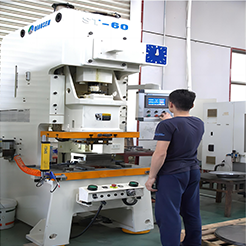
Mastering the Craft: Exploring Conventional Metal Spinning Techniques
Within the domain of metalworking, the artistry of spinning metal holds a revered place, marrying traditional craftsmanship with precise engineering. Conventional metal spinning, an age-old method, embodies a blend of skill, technology, and meticulous craftsmanship, crucial in shaping various metal components with finesse and accuracy.
Unraveling Conventional Metal Spinning
At its essence, conventional metal spinning involves the transformation of flat metal discs or blanks into symmetrical, hollow shapes or components through a process of controlled deformation. This technique primarily employs lathes or spinning machines equipped with specialized tools and molds to gradually shape the metal, typically aluminum, copper, stainless steel, or alloys, into desired forms.
The process commences with the selection of suitable raw material—a crucial determinant of the final product’s quality and properties. The metal blank, securely mounted on a spinning lathe, undergoes rotation while a skilled artisan, known as a spinner, uses hand-held tools or rollers to gradually press and shape the material against a form or mandrel. This interaction between the metal and the forming tools enables the creation of diverse shapes ranging from simple cylinders to complex geometries like cones, hemispheres, or custom profiles.
Principles of Metal Spinning
Fundamentally, metal spinning relies on the application of force and precise manipulation to alter the shape of the metal blank. Through a combination of pressure, controlled movement, and tooling, the metal gradually flows over the form, conforming to its contours. This plastic deformation enables the creation of seamless, hollow metal components with exceptional accuracy and structural integrity.
The spinner’s expertise plays a pivotal role, as their nuanced control over the spinning process determines the final dimensions, surface finish, and structural integrity of the spun metal part. The delicate balance between force application and tool movement, often honed through years of experience and skill, ensures the desired outcome while minimizing material waste and imperfections.
1.CNC Spinning Machine
The CNC (Computer Numerical Control) spinning machine revolutionizes metalworking by seamlessly amalgamating precision engineering with automated control. This sophisticated equipment employs programmed instructions to precisely shape metals into intricate components, offering unparalleled accuracy and repeatability. CNC spinning machines operate through computer-aided designs (CAD) translated into machine-readable code, orchestrating the rotation, tooling movements, and material manipulation. These machines boast versatility, accommodating a spectrum of metals, from aluminum to stainless steel, to craft an array of shapes with minimal human intervention. The integration of CNC technology elevates the efficiency and productivity of metal spinning, catering to industries reliant on high-quality, intricately designed components. CNC spinning machines stand as beacons of technological advancement in the metalworking domain, where precision meets automation to redefine the boundaries of intricate metal component manufacturing.





2.Artificial Spinning Machine
The advent of Artificial Spinning Machines marks a paradigm shift, integrating AI algorithms and robotics to revolutionize textile manufacturing. These cutting-edge machines leverage artificial intelligence to meticulously control spinning parameters, optimizing yarn production. AI algorithms analyze data in real-time, adjusting variables like tension, twist, and fiber alignment, ensuring consistent and superior yarn quality. Robotics aid in automating tasks, enhancing efficiency and minimizing human intervention. These machines offer adaptability, catering to diverse fibers, from natural to synthetic, and facilitating customization in yarn properties. Artificial Spinning Machines epitomize the fusion of AI-driven intelligence and robotics, reshaping the textile industry’s landscape. Their precision, adaptability, and efficiency redefine conventional spinning, propelling the industry towards innovation and sustainability. As technology continues to evolve, these machines stand as beacons of progress in textile manufacturing, where artificial intelligence and robotics converge to elevate quality and productivity in yarn production.

The Spinning Equipment
Conventional metal spinning employs specialized machinery, typically manual or semi-automatic spinning lathes, equipped with various tooling configurations. These lathes feature spinning chucks to secure the metal blank, along with form tools and rollers meticulously crafted to shape and contour the material. The use of lubricants and heat may aid in the spinning process, facilitating smoother metal flow and reducing the risk of surface imperfections.
Moreover, advancements in technology have introduced computer numerical control (CNC) capabilities to metal spinning, enhancing precision and repeatability in creating intricate designs and complex shapes. CNC-controlled spinning machines integrate digital programming, enabling automated and precise control over spinning parameters, thereby expanding the scope of possibilities in metal component manufacturing.
Quality and Applications
The versatility of conventional metal spinning extends across diverse industries, serving applications that demand precision, durability, and customized designs. From aerospace components like rocket nose cones and satellite dishes to architectural elements such as lampshades and decorative fittings, the technique finds applications where intricacy, strength, and aesthetic appeal converge.
Quality control measures, including meticulous inspection of spun components for dimensional accuracy, surface finish, and structural integrity, ensure adherence to stringent standards. The ability to create seamless, single-piece parts with minimal welding or assembly contributes to the superior quality and reliability of metal spun components.
Challenges and Innovations
While conventional metal spinning retains its significance, the industry faces challenges in meeting the demands for faster production rates and highly complex geometries. Emerging technologies like hydroforming and additive manufacturing present alternatives that offer rapid prototyping, intricate designs, and cost-effective production, posing competitive challenges to traditional metal spinning.
Yet, innovation within conventional spinning persists. Advanced tooling materials, enhanced spinning techniques, and the integration of automation and robotics aim to improve efficiency, expand capabilities, and reduce production times. Furthermore, the exploration of new materials and alloys with enhanced properties opens avenues for innovation within the realm of metal spinning.
Conventional Metal Spinning Conclusion
Conventional metal spinning, an artisanal craft merged with precision engineering, continues to shape the metalworking landscape. Its blend of tradition and technological evolution manifests in the creation of bespoke components across industries, showcasing the enduring relevance of this time-honored technique. As the industry navigates technological advancements, the craftsmanship and versatility of conventional metal spinning stand as a testament to its timeless significance.
In the realm of metalworking, where precision meets artistry, conventional metal spinning remains a cornerstone technique, forging seamless components with finesse and expertise. Its legacy endures, weaving a narrative of craftsmanship, innovation, and precision engineering in every spun metal masterpiece.
Exploring Conventional Metal Spinning Techniques

Hot Metal Spinning Process

Punching machine processing service

Centrifugal fan impeller internal welding robot

Lampshade metal polishing process


